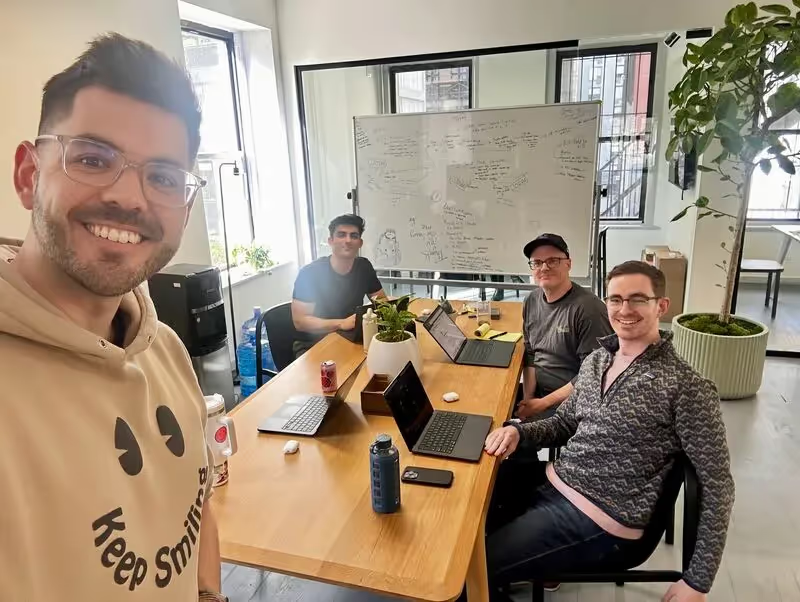How We Use AirOps to Grow AirOps

We build AI workflows for marketers every day, but at our recent growth team offsite we challenged ourselves to become our own best case study.
In the last quarter, our Growth team achieved impressive results:
- Ran 6 webinars with industry leaders (Eli Schwartz, Kevin Indig, Steve Toth, Michael King, George Chaostis, and Will Leatherman)
- Successfully shipped 12 newsletters
- Conversed with thousands of content, SEO, and growth leaders through email and LinkedIn
- Achieved a 50% follower increase across social platforms
- Launched roundtables with incredible growth leaders
- Experimented with 30+ growth plays as part of our GTM Engineering function
During our recent offsite, we asked ourselves: what successful processes could we capture and improve with AirOps?
Our Vision and Mission
At AirOps, our mission is helping leading brands win the battle for attention with content that both humans and agents love.
With that, our growth team—Eoin, Steven, Josh, Joseph, and Cindy—recently gathered to map out our key goals:
- Expand our builder enablement program
- Continue to build a thriving ecosystem through our webinars, content, and GTM experiments.
- 🍾 Become the best team at drinking our own champagne 🍾 (i.e. using AirOps! )
In this post, we'll break down how we built four powerful AirOps workflows that sets us up for compounding growth. This allows us to capture and codify what's working, giving us more time to look for new opportunities to engage our audience.
-min.avif)
Challenges We Faced
Like many teams, we struggled with:
- Content repurposing inefficiencies: We weren’t fully leveraging and distributing our conversations with leaders like Kevin Indig, Eli Schwartz, and more as part of our webinar series.
- Content refresh bottlenecks: We couldn't quickly update existing content with new insights from customers and growth leaders.
- Manual blog recap and follow-up processes: We were spending too much time distilling key takeaways and manually following up people who’d come to our webinars.
- Time-intensive research: We were spending hours creating data-backed social content.
Operationalizing Customer Insights
Through hundreds of conversations with SEO, content, and marketing leaders, we learned a ton about what our users really need and how AirOps uniquely adds value. These conversations revealed three consistent themes:
- Quality still wins — leaders want AI to accelerate production, but only if it strengthens brand voice and drives measurable impact.
- AI is no longer optional — teams that delay adoption are already falling behind faster-moving competitors.
- Workflow fragmentation is the real blocker — most teams aren’t struggling to generate content, they’re struggling to operationalize it.
With that, we spent time aligning on our core messaging and positioning attributes, and locked in our new content style guide.
In AirOps, we mapped this to our own internal brand kit. Brand kits serve as “portable personas” that centralize our brand voice, ICP information, and other important context information ensuring that any workflow within your workspace function as a subject matter expert on your brand.
.avif)
Next, we aggregated our best-performing assets from Q1—sitemap structures, social templates, webinar transcripts, and more—and centralized them in our knowledge base. This becomes the backbone for our workflow development, centralizing our expertise and insights, to fuel more authoritative content.
Having these assets properly structured and organized in our knowledge base helped us determine what workflows to build.
How We Decided Which Workflows to Build?
Now that we were in a position to build, we mapped our team’s specific needs to “jobs to be done” we could create with AirOps.
Our process involved:
- Identifying pain points: Where were we spending disproportionate amounts of time?
- Mapping inputs and outputs: What information did we already have, and what did we need to produce?
- Evaluating impact: Which workflows would save the most time or generate the most value?
- Prioritizing by complexity: Which workflows could be built quickly versus which needed more time and expert development?
This approach helped us focus on four high-impact workflows.
-min.avif)
What We Built and How
1. Webinar Transcript to Social Content (Joseph)
The Need: Our webinars with industry experts like Kevin Indig, Steve Toth, and Eli Schwartz (register for our next webinar here) routinely surface new insights. But deep analysis on the conversation and turning it into an easily digestible format that incorporates our brand voice took hours.
Input: Raw webinar transcripts from our expert interviews
How does it work?
- Retrieves targeted webinar content from our Knowledge Base
- Extracts key insights, quotes, and audience-relevant takeaways from the webinar
- Structures the analyzed content into a standardized JSON format
- Transforms webinar insights into a LinkedIn post matching our brand voice
Output: A batch of ready-to-publish social posts that highlight the speaker’s 1-2 most important points, surprising or contrarian opinions they’ve developed by being in the market, and the workflows they use themselves.
Impact: What once took 5-6 hours now takes 20 minutes. We've increased our content output while maintaining consistent quality and expert attribution.
2. Intelligent Content Refresh (Eoin)
The Need: Our blog content needed continuous updating with fresh insights from our bi-weekly webinars, but manually reviewing and updating posts was creating a bottleneck. Finding the relevant content was difficult, and fully expressing the insights shared had started to become far too time consuming.
Input: New content from webinars (expert quotes, statistics, insights) and our existing blog archive
How does it work?
- Scrapes and cleans content from existing post on the webinar
- Extracts keywords and main insights from blog and transcript
- Human Review on the keywords to pursue for optimization
- Searches Knowledge Base for relevant content matches, per keyword
- Generates 2 types of optimization suggestions – presents anchor texts for internal linking and proposes new sections to upgrade existing articles
- Consolidates recommendations per page across keywords to avoid duplicate or conflicting ideas
- Human Review to approve suggestions before changes are incorporated
- Applies approved changes to existing content, while maintaining brand consistency, tone of voice and unique perspective shared by webinar guest
- Exact updates to content are clearly presented with reasoning to be accepted, rejected or tweaked.
- Approved changes are sent to the CSM and automatically re-published.
Output: Content enriched with insights from thought leaders, reviewed by expert-in-the-loop, and published in CMS.
Impact: Blog refresh time reduced by 90% and each relevant piece of content is now enriched with key insights to push the conversation forwards. Internal linking and expert attribution is now automated with reviews at key moments. Our evergreen content now improves and evolves with time.
Workflow in Action:
3. Automated Blog Recap & Email (Josh)
The Need: Our webinars contained valuable insights that needed to be transformed into both shareable blog content and personalized attendee follow-ups—a process that was taking hours of manual work.
Input: Webinar transcript, webinar brief, and attendee registration data
Recap Generation - How does it work?
- Analyzes webinar transcript and brief to extract key quotes, takeaways, topics, and resources
- Formats search query using extracted topics for knowledge base search
- Generates comprehensive blog post incorporating webinar insights, quotes, and resources with brand-aligned messaging
Follow0up Email - How does it work?
- Builds upon the above by creating a follow-up email for webinar attendees with key insights and a call-to-action
Output: A polished blog post ready for publishing, and a structured follow-up email with key takeaways, standout quotes, and an "insights into action" section
Impact: Follow-up time reduced from 3 hours to 20 minutes per webinar, with higher engagement rates.
4. Deep Research to Weekly Roundup (Steven)
The Need: Creating data-backed industry updates required extensive manual research across multiple sources.
Input: Brand kit and primary topic selection (Industry News, Top Builders, or Top Jobs)
How does it work?
- Converts topic selection to targeted search queries
- Performs deep research across relevant sources
- Analyzes results for search intent and brand alignment
- Extracts and structures relevant data points
- Generates LinkedIn posts in our consistent brand voice
Output: Professionally crafted LinkedIn roundups with consistent brand voice and relevant industry insights
Impact: Research time reduced from 4+ hours to under 30 minutes, enabling consistent weekly publishing of high-engagement industry content
Ready to bring your idea to life?
Hopefully you've been inspired to try building yourself. Here's top tips from our Growth team on how to identify and build workflows that will make an impact:
- Map your content flow: Identify where content originates and where it needs to go
- Spot the bottlenecks: Which processes take the most time or cause the most frustration?
- Define clear inputs and outputs: What exact information goes in, and what should come out?
- Start small and iterate: Begin with simple workflows that solve immediate pain points
- Measure the impact: Track time saved and content quality to demonstrate ROI
We’d love to help you with any (or all) of the above!
Grab a free strategy session with our team here.
Interested in seeing more Content Engineering?
Want to see how AirOps can transform your content operations?
- Join our builder cohort: Learn content engineering directly from our in-house experts alongside leaders from Notion, Webflow, Zapier, and more.
- Attend our webinar series: We host sessions with organic growth leaders like Kevin Indig, Eli Schwartz, Steve Toth, and more. See who’s next up here.
- Book a demo: Discover how to capture and scale your specific content strategy with one of our expert content engineers - Book a demo.
Win AI Search.
Increase brand visibility across AI search and Google with the only platform taking you from insights to action.
Get the latest on AI content & marketing
Get the latest in growth and AI workflows delivered to your inbox each week


.avif)
.png)

